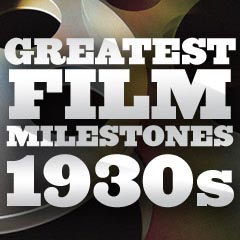
|
Milestones and Turning Points in Film History The Year 1937 |
![]()
(by decade and year) Introduction | Pre-1900s | 1900s | 1910s | 1920s | 1930s | 1940s | 1950s 1960s | 1970s | 1980s | 1990s | 2000s | 2010s | 2020s |
| Event and Significance | |
| Walt Disney's Silly Symphonies short animated film, The Old Mill (1937), was the first cartoon to be produced with the $70,000 multi-plane camera, which gave an increased sense of movement and depth of image, facilitated panning shots, and enabled more elaborate effects. It won the Academy Award for Best Animated Short Film in 1938. | |
| The first full-length animated feature, Disney's Snow White and the Seven Dwarfs (1937), was released - made for a budget of $1.5 million. It was the top moneymaker in 1938, when it made an astronomical $8 million. It was the first film with an official soundtrack, and the first film to release a motion picture soundtrack album. | |
| The first film pairing of young stars Mickey Rooney and Judy Garland was in Thoroughbreds Don't Cry (1937). | |
| In a small breakout role in her debut film They Won't Forget (1937), 16 year-old Lana Turner was featured with a sexy, tight-sweatered walk - it made her "the Sweater Girl" and launched her career. She portrayed teenaged Mary Clay - who was murdered in a school-house in the opening sequence during a Southern town's Memorial Day parade. | |
| Judy Garland sang: "Dear Mr. Gable" to Clark Gable as a present during his 36th birthday party held on the MGM lot. Composer and arranger Roger Edens had adapted the old song "You Made Me Love You" by James V. Monaco - it was so well-received that Garland reprised it for her next film The Broadway Melody of 1938 (1937). It was Judy's second feature film, and her first film for MGM. | |
| Daffy Duck's first appearance was in animator Tex Avery's and Warners' short cartoon Porky's Duck Hunt (1937). Daffy (unnamed in the cartoon short and only a bit player) was more duck-like than its later iterations. | |
| Luise Rainer won the second of her back-to-back Best Actress Oscars for her performance as the strong and silent O-Lan, a self-sacrificing Chinese peasant farm wife in The Good Earth (1937). Her first win was for her performance in The Great Ziegfeld (1936). She became the first multiple Oscar winner, and was the first to win an award two years in a row. Her win was one of the few instances in which an actor/actress portrayed a person of a different race. | |
| During his long film career, top star in the mid-1930s Clark Gable was often paired with Myrna Loy (he appeared with her in seven films). In a poll taken by newspaper entertainment columnist and radio star Ed Sullivan (later a legendary TV variety show host) in 53 newspapers in 1937, 20 million fans voted Clark Gable and Myrna Loy as the "King and Queen of Hollywood." The couple were presented with crowns by Sullivan on the steps of the El Capitano Theatre. However, there were allegations of rigged voting and a substantial cash contribution from MGM. The title of "King" remained with Gable to his death, and then was passed onto Elvis Presley. | |
| The musical comedy A Damsel in Distress (1937) (with music and lyrics by George and Ira Gershwin and based on a P.G. Wodehouse story) was best known as the first Fred Astaire/RKO film to not feature Ginger Rogers (non-dancer/singer Joan Fontaine was substituted), after they had famously teamed up together in Flying Down to Rio (1933) - and most recently in Shall We Dance (1937). It was also the first Astaire film to be a box-office flop. To make up for their miscalculation, RKO quickly recast the celebrated dance team of Astaire and Rogers in the next year's Carefree (1938). | |
| Blonde bombshell Jean Harlow was the first film actress to appear on the cover of the popular Life magazine, on May 3, 1937, only a month before her tragic death at age 26 on June 7, 1937 due to uremic poisoning, before the completion of filming for Saratoga (1937) with Clark Gable. | |
| The first 3-strip Technicolor film shot in Europe (in the British Isles) was the dramatic romance Wings of the Morning (1937, UK). | |
| Chester Gould's comic strip police detective character Dick Tracy made his first appearance in film in Dick Tracy (1937), a Republic Pictures movie serial starring Ralph Byrd. | |
| The first issue of the comic book Detective Comics was published in March of 1937. In March of 1939, Detective Comics introduced Batman in issue No. 27. Batman was the first DC Comics character to have his own serial, Columbia Pictures' 15-episode serial Batman (1943). | |
| Louis B. Mayer (of MGM studios) had the highest salary in the US at $1.3 million. | |
| Six of the original members of "The Dead End Kids" (young New York actors Huntz Hall (Dippy), Billy Halop (Tommy), Bobby Jordan (Angel), etc.) reprised their 1935-1937 Broadway stage roles in the Hollywood film version, UA's crime drama Dead End (1937) opposite Humphrey Bogart. It was their first film appearance, and they went on to make more films, including Warners' popular Angels With Dirty Faces (1938). They would also adopt other names for the group, such as East Side Kids, Little Tough Guys, the Bowery Boys, etc. | |
| Producer Jed Buell's Harlem on the Prairie (1937) was billed as the first all-black ("all-colored") western musical of the sound era (it was a 'singing-cowboy' film). It was the first all-colored picture to play on Broadway in a first-run theatre. Three similar films followed: Two Gun Man From Harlem (1938), The Bronze Buckaroo (1939), and Harlem Rides the Range (1939). |